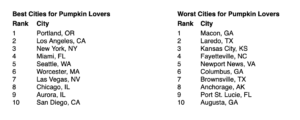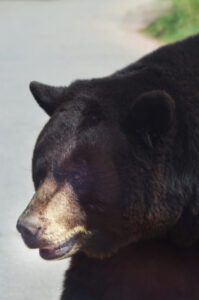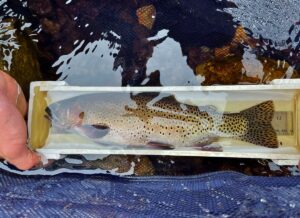Area 1 – Clear Creek, Gilpin, Park and west side of Jefferson counties
“In Area 1, we had a good spring with moisture, and didn’t have the hard freeze other places had. Summer was good and had ample precipitation and the vegetation responded favorably. There were places with bumper crops of chokecherries and you would think bear-human conflicts would be down, but unfortunately that was not the case.
“We continue to have issues with hobby livestock operations, mostly chickens, ducks and turkeys left unprotected. A lack of Bear Aware knowledge led to most of the conflicts we saw this year and continuing to spread awareness of best practices in bear country is vital to reducing conflicts. A few people were cited for intentionally luring bears (aka feeding). This is probably one of the most selfish acts people can do to bears. It impacts their neighbors and, most importantly, influences and changes bear behavior.
“Break-ins to unoccupied cabins and houses were way up in Area 1 and wildlife managers are trying to figure out why. It seems some rural/foothills bears have been habituated to living near humans who are not bear-wise. These bears’ behavior has progressed from wandering near homes, getting into trash/bird feeders, then going on decks to find more bird feeders/pet food, to becoming more habituated and entering houses. Fortunately, most houses that they have broken into have been unoccupied, but it is still a concerning trend.” ~ Mark Lamb, Area 1 Wildlife Manager
Area 2 – Boulder County, Broomfield, the southern portion of Larimer County including Loveland, portions of southwestern Weld County
“Human-bear interactions have been high this year in Area 2. Trash, bird seed, beehives, livestock, tents, homes/garages, vacation cabins, vehicles and pet food have all been targets. The public should haze bears using whatever methods they are comfortable with (noise, bear spray, water hose, etc.) Make sure to call CPW during business hours, or State Patrol Dispatch after hours (303-239-4501), to report any bear incidents so that we can respond appropriately.” ~ Jason Duetsch, Area 2 Wildlife Manager
Area 3 – No reported bear activity in northeast Colorado
Area 4 – Larimer and Weld counties
“The natural forage for bears in Area 4 was fairly productive this year. Despite that, we did see more bear conflicts with automobiles and houses this year than we were expecting. The communities northwest of Fort Collins and the communities in the foothills experienced a high number of bears entering homes, automobiles, travel trailers and RVs. Fortunately, we did not have a large number of conflicts at campgrounds in the Poudre Canyon. This may be due in part to the U.S. Forest Service instituting regulations pertaining to bear-resistant containers as well as the installation of containers at some campgrounds. We did have several bears in the city of Fort Collins this year. We relocated several bears that were highly visible in neighborhoods and also removed a bear from CSU’s campus. Most of these were younger bears and they were getting into trash cans. Fortunately, we did not have any major issues in terms of conflicts within the city.”~ Jason Surface, Area 4 Wildlife Manager
Area 5 – Denver Metro Area counties (Adams, Arapahoe, Denver, Douglas, Elbert, Jefferson and portions of Broomfield County)
“Bear activity and human conflict continues to be an issue. Residents should be reminded to secure their trash and not put it out until the morning of trash pickup. Residents are also reminded to close their garage doors, lock their cars and remove bird feeders/hummingbird feeders to prevent bears from becoming habituated to human provided food sources. Drought conditions exist in most of Area 5 and natural food sources for bears remain inconsistent across the area. Residents are also reminded that feeding bears is illegal and creates a public safety issue.” ~ Matt Martinez, Area 5 Wildlife Manager
Area 6 – Rio Blanco and Moffat counties
“Area 6 has seen a higher number of human-bear interactions this year than in the past. The conflicts involve mostly younger bears looking for food and getting into the urban interface of their habitat. There was a late, hard freeze in May that has caused a loss of most of the berries and acorns so bears are looking for alternative food sources. Game damage claims with bears killing domestic sheep appears to be high this summer.” ~Bill de Vergie, Area 6 Wildlife Manager
Area 7 – Grand Junction; Mesa and Garfield counties
“This year from Fruita to New Castle we have seen more conflicts within town limits. Much of this activity is related to the food failure early this summer. We are seeing bears move into areas that we normally do not have them reported. We’re encouraging everyone to make sure that attractants like trash, bird feeders, and barbecue grills are properly stored to not attract bears. Additionally, residents should secure doors and close garages. If residents see bears in urban areas or have bears creating issues in the rural areas, please reach out to the local CPW office so we can prevent serious problems before they happen.” ~Kirk Oldham, Area 7 Wildlife Manager
Area 8 – Aspen, Glenwood Springs; Eagle and Pitkin counties
“Overall, the continued drought cycle has resulted in poor natural food production in most of Area 8. Natural berry and acorn crops were almost non-existent in many areas, similar to the past few couple years. However, bear litter sizes continued to remain high with several sows in the area having three or even four cubs. Considering the lack of natural foods, this indicates to local wildlife managers that supplementary food sources are helping bears circumvent natural control measures that mother nature employs to maintain sustainable populations. It’s no surprise that these supplementary sources continue to be unsecured trash, bird seed and residential fruit trees. As a result, there continues to be a high number of bears inhabiting municipalities across both valleys and a subsequently high number of human-black bear conflicts.” ~ Matt Yamashita, Area 8 Wildlife Manager
Area 9 – Breckenridge, Hot Sulphur Springs and Granby; Grand and Summit counties
“In Area 9, conflicts are up slightly from last year. We’ve seen a significant increase in unnecessary conflicts with bears in Grand County as result of poor trash management and bird feeding activities despite a decent natural food year. We are thankful that some residents are being responsible and have taken action to live with wildlife, but it ultimately takes a community effort. We continue to ask residents and guests to remove attractants, secure your homes, camp responsibly, and remember to lock your vehicles. It takes everyone doing their part to care for Colorado’s wildlife.” ~ Jeromy Huntington, Area 9 Wildlife Manager
Area 10 – Steamboat Springs; Jackson and Routt counties
“In Routt and Jackson counties, we have had fewer reported human-bear interactions, but bear activity has remained steady within the city limits of Steamboat Springs. We are seeing more compliance with people having bear-resistant trash receptacles, but proper use still seems to be an issue. With bears continuing to get an easy meal at many places in town, it is not uncommon to see bears daily in most of our neighborhoods. These habituated bears have not learned a healthy fear of people, which has led to an uptick in bears entering unsecured homes. It is important that CPW is notified as soon as possible when conflicts arise so that we can help with the situation before a bear becomes habituated. In partnership with Colorado Parks and Wildlife, a new community Bear Aware program was initiated last winter that has reached several thousand visitors and locals to help spread the message about the importance of proper etiquette when living and visiting bear country.” ~ Kris Middledorf, Area 10 Wildlife Manager
Area 11 – Pueblo, Trinidad, South-Central Colorado
“Area 11 is having fewer human-bear interactions this year compared to last even with a significant freeze that occurred throughout the foothills and higher elevations. The late spring snow/freeze impacted acorn production but these impacts seemed to be sporadic and elevation dependent. Great summer precipitation has led to abundant fruit and grass production throughout the area. With bears having an increased utilization of fruit across the landscape, portions of Area 11 have seen an increase in bears being killed by vehicles as they travel to seek out those food sources. The majority of human-bear interactions within the area have been a result of unnecessary conflict due to poor trash management, storage of pet food, and unprotected beehives. Additional conflicts have arisen from leaving doors and windows open in addition to irresponsibly camping in bear country. We ask residents of southern Colorado to secure their trash by utilizing a bear-resistant dumpster. We also ask residents and visitors to lock their cars, secure their homes and remove any attractants to prevent any conflicts with bears. For advice and tips, folks can reach out to local district wildlife managers to help bear-proof their residence.” ~Mike Brown, Area 11 Wildlife Manager
Area 12 – Las Animas, Baca and Otero counties
“There have only been a few bear reports in southeast Colorado coming from Las Animas, Baca and Otero County.” ~ Todd Marriott, Area 12 Wildlife Manager.
Area 13 – Chaffee, Fremont and Lake Counties
“The Upper Arkansas Valley, including the area around Leadville, Buena Vista, Salida and Cañon City, had a late cold snap in the spring. Unfortunately, the cold snap was right when many fruit trees and shrubs were flowering, leading to very little fruit and acorn production as their flowers were lost to the freezing temperatures. The Upper Arkansas Valley did have regular rain throughout the summer and there are pockets of fruit and acorn production, but it is inconsistent. Bear activity has been steady throughout the area and there are still reports of bear issues around homes. We continue to encourage people to remove and minimize attractants around their homes. Attractants include bird feeders, any fallen fruit, and, of course, trash. Colorado Parks and Wildlife recommendations to reduce conflicts with wildlife, including bears, only work if homeowners and visitors consistently follow the suggestions. We have had success educating residents that have had bear problems and have been able to avoid trapping bears this fall.” ~ Sean Shepherd, Area 13 Wildlife Manager
Area 14 – Colorado Springs, Manitou Springs; El Paso and Teller Counties
“In the Colorado Springs area, we started out with a lot of conflicts due to the drought. Fortunately in mid-June, we received a lot of rain and have been getting plenty of moisture ever since. This improved the availability of natural food sources and led to a relatively mild year for bear conflicts. The city trash ordinance on the west side of town has helped reduce conflicts over the last few years. We did receive a late freeze in May that may reduce some of the mast crop in the area, so conflicts may go up again as we move into the fall, but only time will tell. We continue to encourage people to keep their garage doors closed and secure all food and scent attractants.” ~ Tim Kroening, Area 14 Wildlife Manager
Area 15 – Durango
“Area 15 had an average year for bear conflicts area-wide. Southwest Colorado received good moisture this summer and the availability of natural food sources has been good. The majority of conflicts reported were due to unsecured trash and other outdoor food sources. We would like to remind people to do their part in removing or securing all possible attractants and to work with neighbors or guests in doing the same. A couple of our communities received CPW bear grant funds this year and we are looking forward to these bear conflict mitigation resources being applied to help reduce conflicts in the future. Please continue to report bear conflicts to the local CPW Durango office in a timely manner so that we and other partners can provide assistance in mitigating conflicts before bears become habituated.” ~Adrian Archuleta, Area 15 Wildlife Manager
Area 16 – Gunnison Basin, North Fork Valley
“This year in Area 16, our bear conflicts are up compared to 2021. Mast production in the Gunnison Basin was good, but more spotty than last year, and we have continued to experience some bear conflict throughout September. In the North Fork Valley, a late freeze contributed to what appears to be a significant decline in mast crop production, particularly acorns in oakbrush habitats. Other mast species such as chokecherry and serviceberry may have also been impacted by spring cold snaps, and significant bear activity has been reported in and around the communities of Paonia, Hotchkiss, and Cedaredge. Bears will continue to be very active until hibernation, so we strongly encourage all of our local residents to assess their properties and remove potential bear attractants. These include trash, bird feeders, pet food, fruit trees and fruit waste. Homeowners can also help avoid bear conflicts by locking their car doors at night and securing lower-level windows and doors. CPW continues to seek long-term solutions for mitigating bear conflicts across our communities, but in the short-term we ask that the public continue to work with us to ensure that bears stay wild.” ~ Brandon Diamond, Area 16 Wildlife Manager
Area 17 – San Luis Valley
“It has been a pretty normal year for bear activity in our area. We did have really variable conditions this year. Early on, we had drought conditions. But once we started getting rain, there were available food sources for our bears. Our conflict areas have been the normal areas we usually see in Creede, South Fork and Crestone. We will always have some human-bear issues in those areas because the food is easy to get there and it’s been hard to dissuade those bears in those areas. But once the rains kicked in, it really seemed to help in most places. We’ve had a few problems, but it has been a manageable year and we haven’t had to handle many bears.” ~ Rick Basagoitia, Area 17 Wildlife Manager
Area 18 – Incorporating Montrose, Delta, Mesa Ouray and San Miguel counties
“Unfortunately, a late frost impacted many of our natural fruit and mast crops across the area. A long monsoon season brought much-needed moisture during the growing season so grasses and forbs grew well. However, berries, acorns, and nuts are very spotty this year. As fall progresses, we ask for increased diligence in keeping human and bird food sources put away so we don’t lure bears with high-calorie treats they want in preparation for winter.” ~ Rachel Sralla, Area 18 Wildlife Manager
Become Bear Aware
Colorado Parks and Wildlife offers a reminder that by taking some simple precautions, you can avoid human/wildlife conflicts and help to keep bears wild.
Bearproofing your home:
- Keep garbage in a well-secured location. Only put out garbage on the morning of pickup.
- Clean garbage cans regularly to keep them free of food odors: ammonia is effective.
- Keep garage doors closed.
- Use a bear-resistant trash can or dumpster.
- Don’t leave pet food or stock feed outside.
- Bird feeders are a major source of bear/human conflicts. Attract birds naturally with flowers and water baths. Do not hang bird feeders from April 15 to Nov. 15.
- Don’t allow bears to become comfortable around your house. If you see one, haze it by yelling at it, throwing things at it and making loud noises to scare it off.
- Secure compost piles. Bears are attracted to the scent of rotting food.
- Clean the grill after each use, clean-up thoroughly after cookouts.
- If you have fruit trees, don’t allow the fruit to rot on the ground.
- Talk to your neighbors and kids about being Bear Aware.
Cars, traveling and campsites:
- Lock your doors when you’re away from home and at night.
- Keep the bottom floor windows of your house closed when you’re not at home.
- Do not keep food in your vehicle; roll up windows and lock the doors of your vehicles.
- When car-camping, secure all food and coolers in a locked vehicle.
- Keep a clean camp, whether you’re in a campground or in the backcountry.
- When camping in the backcountry, hang food 100 feet or more from the campsite; don’t bring any food into your tent.
- Cook food well away from your tent; wash dishes thoroughly.
Protecting your chickens, bees, livestock:
- Keep chickens, bees and livestock in a fully covered enclosure, especially at night.
- Construct electric fencing when possible.
- Don’t store livestock feed outside.
- Keep enclosures clean to minimize animal odors.
- Hang rags soaked in ammonia and/or Pine-Sol around the enclosure as a scent deterrent.
|



